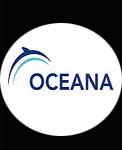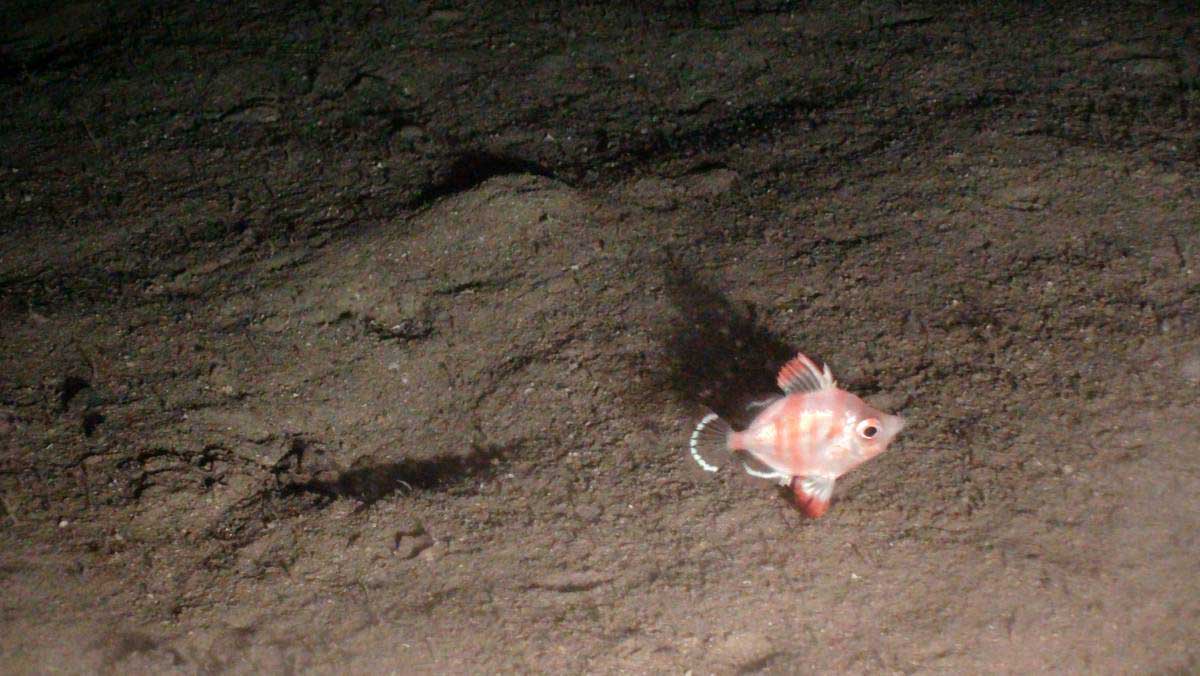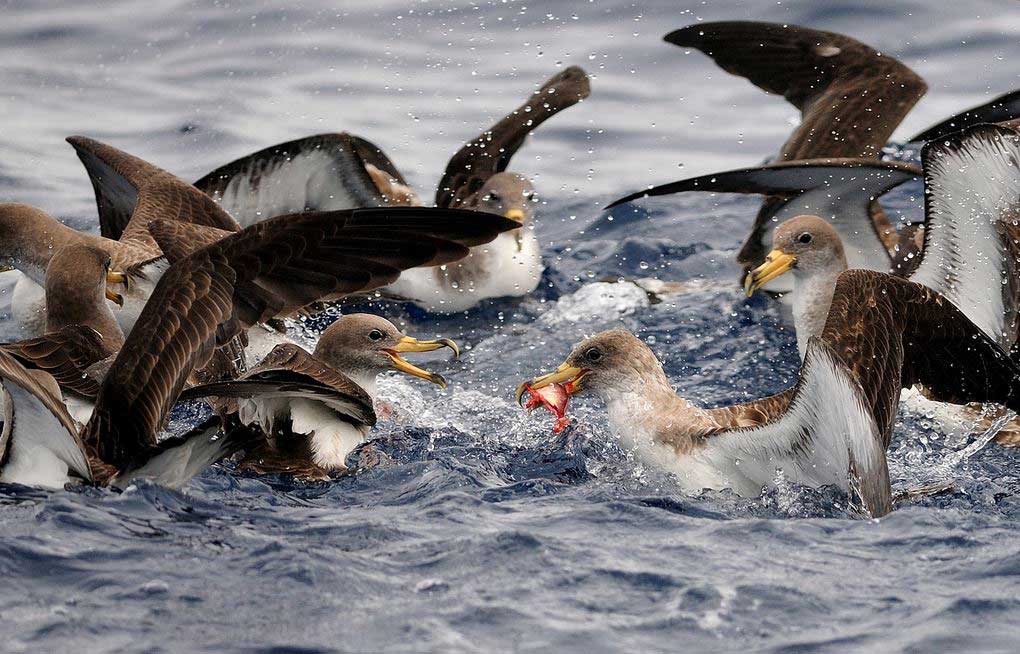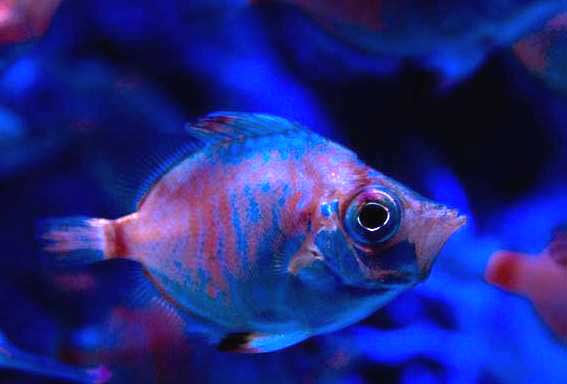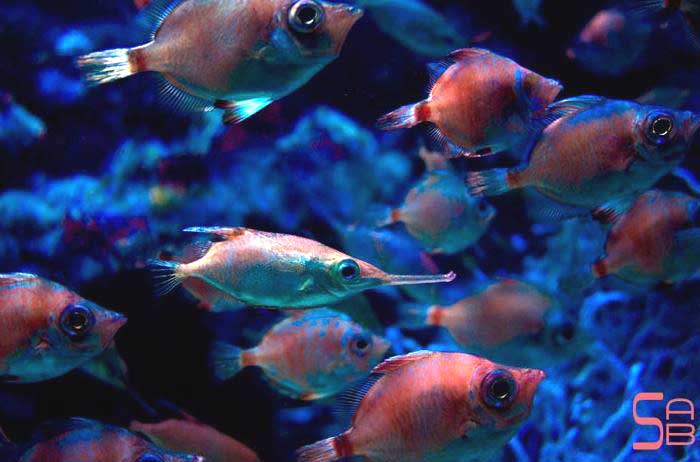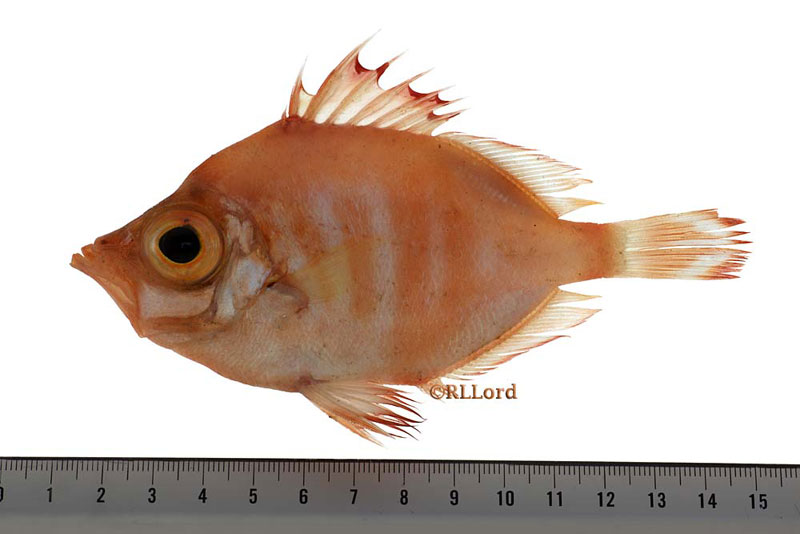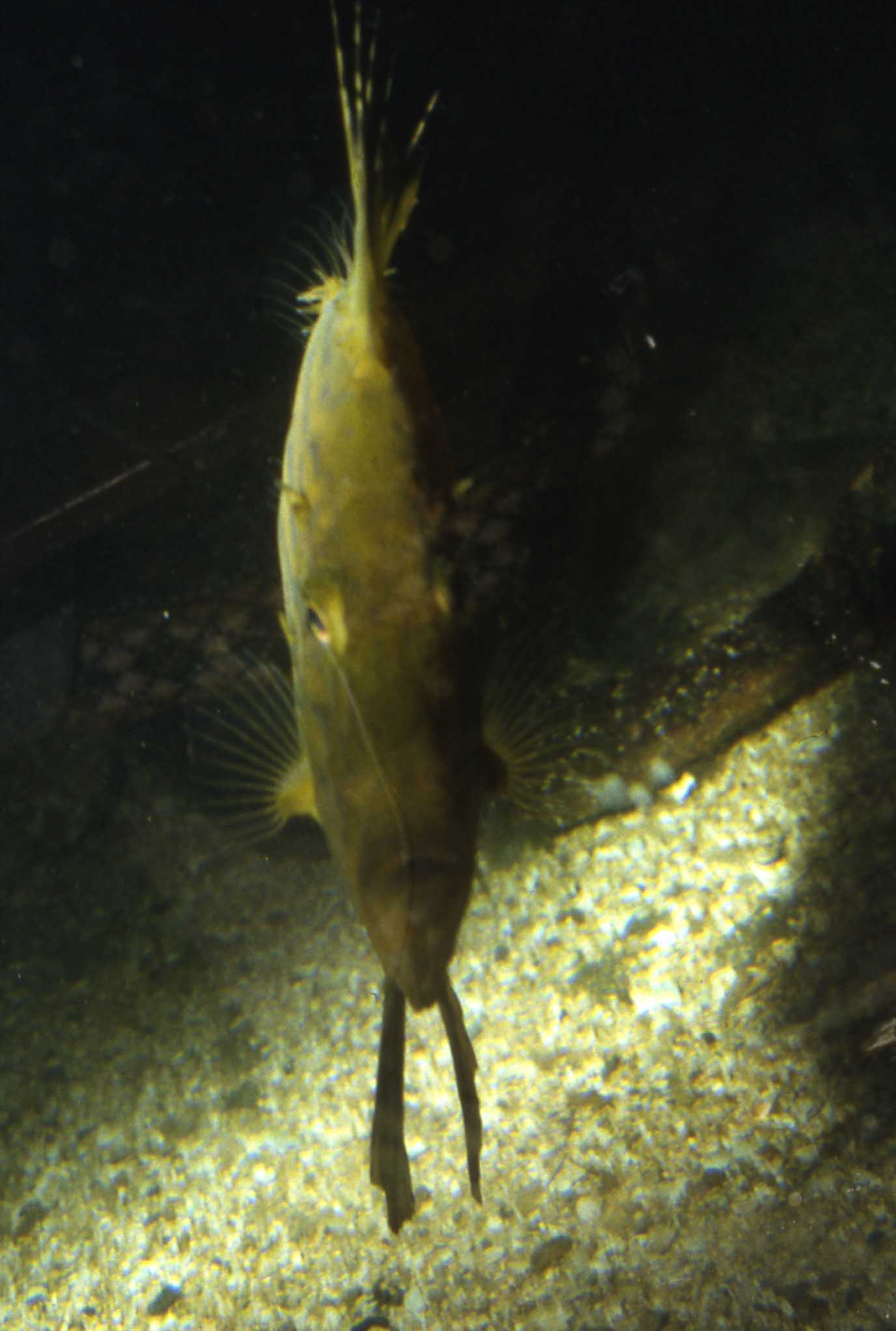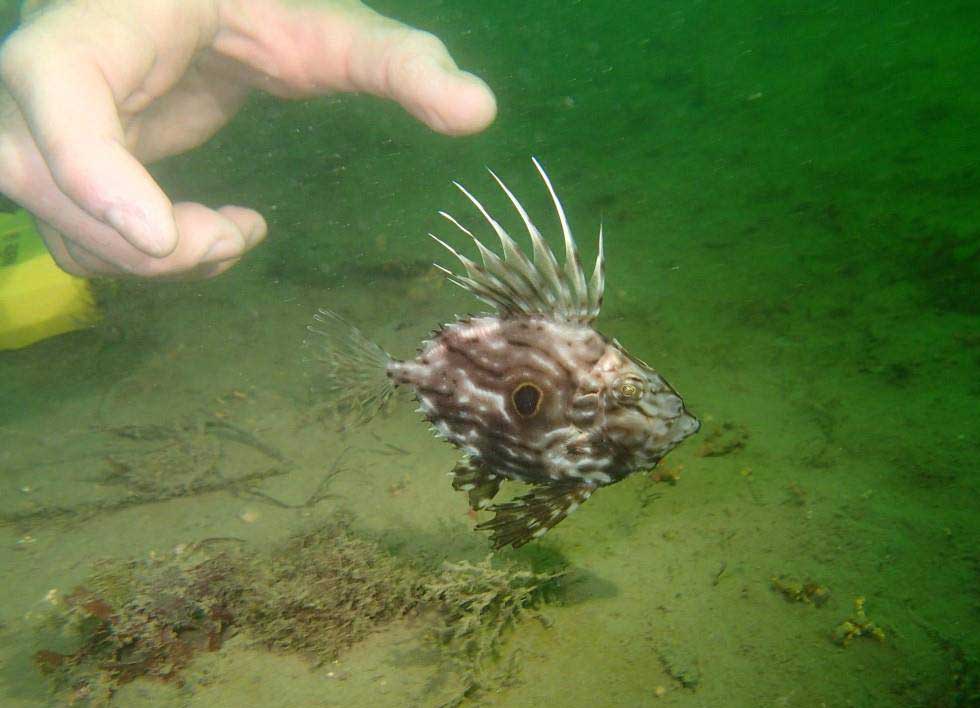
|
|
| Placozoa |
| Porifera |
| Cnidaria |
| Ctenophora |
| Mesozoa |
| Platyhelminthes |
| Nemertina |
| Gnathostomulida |
| Gastrotricha |
| Rotifera |
| Kinorhyncha |
| Loricifera |
| Acanthocephala |
| Entoprocta |
| Nematoda |
| Nematomorpha |
| Ectoprocta |
| Phoronida |
| Brachiopoda |
| Mollusca |
| Priapulida |
| Sipuncula |
| Echiura |
| Annelida |
| Tardigrada |
| Pentastoma |
| Onychophora |
| Arthropoda |
| Pogonophora |
| Echinodermata |
| Chaetognatha |
| Hemichordata |
| Chordata |
| TELEOSTEI |
|
|
Boar
Fish (This
name was a mistaken transcription in the old books)
Zulu
Fish (Colloquial from Cornwall)
 |
Common
Name(s):
Boar Fish, Zulu Fish Scientific Name: Capros aper Family: Weight:
>
85 g ?
|
| Identification:
Pretty little red and silver fish about 55 mm long, excluding its caudal fin, large eye and protractile mouth, with a spiky first dorsal and vibrating second dorsal and second anal fins (vibrating like the dorsal fin of a pipefish). "Compressed from side to side so it looks like a flatfish set on edge." (Brightwell) A.Wheeler-1
(CD-ROM) only
Record
Angling catch:
Shallow water specimens of the Boar Fish can be a straw-yellow colour instead of red. Comments
on the Common Name:
Aristotle
(Aristotle 535b, 18) described Capros as a river fish that made a grunting
noise.
Discussion
on Fishing News
facebook
Breeding:
Habitat:
Bathymetric: Behaviour:
Additional Notes:
Cory's
Shearwater
Afterthought: this may be a discarded catch? Aquarium Observations:
Capros
aper shoaling
Aligns itself at an oblique angle to the current at night and sometimes at other times. Very nervous disposition and will not feed for several days if netted and moved or after being caught. This is a slight problem. Feeds on live daphnia and frozen brine shrimp, but needs encouragement to feed and this is a worry at first. Finicky feeder, usually taking food only of its preferred size, e.g. my small 55 mm fish will prefer frozen Artemia to frozen mysis. After a bit (2 weeks), the fish will now take frozen mysis as readily as Artemia (brine shrimp). Will feed constantly and becomes a more aggressive feeder after a month in captivity. Very sensitive to light levels, attracted to low levels of light when its tank light is off. (February - April 2003) Has been observed eating large particles of boiled mussel which it can chop off so it does not need to eat the whole bit, (if it contains the byssus threads etc.) (May 2003) The BOAR FISH died on 3 June 2003 after the tank sprung a leak. The fish weighed 22 grams (fatter than when caught when it looked slightly malnourished). (The fish was transferred to another tank, which probably had insufficent oxygen during the emergency flooding (which threatened the electrical supply). The tank had Corkwing Wrasse, Symphodus melops, and Bullhead, Taurulus bubalis, at 22° C so the oxygen requirements are high and it appeared OK at first. By the time I had gone out of the room to set up an additional air pump it had keeled over and could not be revived. (This is unusual.)
Reports:
Shoal
of Capros aper
An interesting observation in Sea of the Hebrides (NW Scotland) this summer. During a copepod plankton bloom we witnessed a large shoal of boar fish (Capros aper) in deep water. We have seen a few individuals in the shallows over the years but nothing like this. Next day with stronger winds we saw a smaller shoal in the harbour which later disappeared. Seas of the Outer Hebrides
27
September 2012
Report
and Image on Sealife
Survey facebook
21 April
2011
A Boar Fish (or Zulu Fish), Capros aper, was behaving strangely, swimming near the surface on an exposed rockpool at Challaborough Beach, south Devon, and we moved it from where we found it to a more secluded pool. Report
by Victoria Shore
This is only the second Boarfish I have seen from Guernsey waters. The first one I saw was landed by Guernsey commercial fisherman Shane Petit on 23 February 2002. Boarfish are common in deep water of the western English Channel but rarely strays east up the Channel. The fish's large eye and the orange/ red colour is well suited to deep water as the longer wave length of red light is absorbed by water before the blue and greens (which are reflected) and therefore red coloured marine species appear dark or black at depth. The Boarfish, like the John Dory, has a protrusible (telescopic) mouth, which is used for catching small species. Report,
Photograph
& Comments by Richard
Lord (Guernsey)
Sealord
Photography
29
July 2007
Report
by Mark Wright
21 January
2006
A Boar Fish, Capros aper, was washed up alive on on at Branksome Chine, Dorset (near Bournemouth). It was thrown back in the sea but it may get washed up again. This attractive deep water fish is very occasionally washed up alive or found in rock pools and very occasionally caught by anglers. Report
and Photograph by Robert Aquilina (Oxford
Brookes University)
via Julie Hatcher (Secret Life at Low Tide) and Doug Herdson (National Marine Aquarium at Plymouth)
Report
from Doug
Herdson (National
Marine Aquarium, Plymouth)
2 November
2002
Late
October 2002
Report
by Chris Gilbertson
(Mevagissey Harbour Aquarium)
May 2002
 A
Boar
Fish,
Capros
aper, was also caught close inshore
to Mevagissey, Cornwall, in a Pilchard net and it is one of two of these
attractive fish on display in the aquarium. A
Boar
Fish,
Capros
aper, was also caught close inshore
to Mevagissey, Cornwall, in a Pilchard net and it is one of two of these
attractive fish on display in the aquarium.
Report
by Chris Gilbertson
(Mevagissey Harbour Aquarium)
Report
by Richard Lord (Guernsey)
A diver also thought he spotted a Boar Fish (2001 ?) off the Isle of Wight. 26
December 2001
20
November 2000
Report
by Gavin
Black via the Marine
Wildlife of the North-east Atlantic Ocean Group
Report
on 7 November 2002
by Mr. Viv Smith (Shoreham beach)
In April
1991, a small Boar Fish was caught by a fisherman
off south Cornwall and spent several years in Mevagissey
Aquarium.
1990
Historic
Record:
I have traced just over 20 records form Cornwall (on the databases held by the Environmental Records Centre for Cornwall and the Isles of Scilly) which, include one or two from the Scillies, ranging from 1825 to 2001, Some years it is very common (over 1000 trawled in one week in September 1983) but it seems to be very variable in numbers and may be absent over a span of years, or just found in ones and twos. Some are strandings, kept on the Strandings Database, and one was still live in a rock pool - but usually they are in deeper water. Report
from Stella Turk on
the Cornish Mailing
List
Boar Fish from Hove (d. June 2003) CORNISH RECORDS OF THE BOAR-FISH OR ZULU, CAPROS APER Numbers is smaller font are the numbers assigned on the ERICA database (so I can check any queries about the entries). A couple without numbers are on the strandings database. 1825 One in Mount’s Bay, sent to the Zoological Society as a very rare fish (Yarrell 1841) (Y93794) One of rarest fish since 1843 when it appeared in large numbers from Plymouth westwards. There were none in 1844, and since then it has been present only in small numbers (Clark 1909) (10482 -10483) Plentiful in 1870 and "a veritable pest" from 1870-1879, often filling the trawls. There was a violent storm in 1879 and then it did not appear again until 1894 (Clark 1909) (10484, 10485- 10486) 1870s Off Prussia Cove (SW52) – described as one of our rarer fish (Cornish 1878) (10494) Frequent in early 1900s especially in crab pots set with spider crab bait (Clark 1909) (10488) One in St Ives Bay *(SW54), early 1900s. (Vallentin 1907) (10489) Oct.1951-March 1952 Large numbers on several occasions. Since then only 1 2o 3 a year. G. A. Steven in Plymouth Marine Fauna (1957) (10479) 1964 Isles of Scilly (Isles of Scilly Museum list of fish1988) (I229) 1975 One 10 cmsalive in rock pool, Prussia Cove (SW52) (Derrick Potton) (1475) 1983 Three trawled 10 miles S. of Falmouth (P. A. Gainey) (19496) 19/9/1983 After several days of storms, over 1000 trawled 25-40 m. off Falmouth in one week (P. A. Gainey) (10492) 1983 Taken by angler off Rinsey Head (SW52) (Y63638) April 1989 Off Fowey )SX15) (Sarah Matthews) (C791) Feb. 1991 Stranded at Downderry(SX£65) photographed by S. C. Madge (P103835) 20/11/2000 One stranded at Porth Kidney, Lelant )SW53) (Alan Matthews) 26/12/2001 One dead on strandline, Perranporth (SW75) (Tony Davis) J.T. Cunningham in the Victoria County History of Cornwall (1906) mentions it being found on the beach at Brighton in 1842. It was sent to Buckingham Palace (for some reason) where the Prince Consort identified it. Clark, 1909. Reprinted from ‘Zoological Papers’ in Zoologist 1907 and 1908. Yarrell, W., 1841. British Fishes. London: van Voorst. Report
from Stella Turk
I'm not too surprised
by the presence of the Boar
Fish (Capros aper), off Sussex. A few years ago I was carrying out some research work off the Irish coast aboard a super crabber, they loaded boxes of Boar Fish (Capros aper) for use as bait!! which puzzled me at the time as the size would hardly put out a significant scent to entice macro-crustacea. However, once the pots had begun to be hauled and nearly every other pot had a conger eel in, the reasoning became clear. The conger eel were cut up into steaks/chunks and used for bait with the Boar fish (Capros aper) merely used to bulk out the bait. I questioned the skipper as to the source of the Boar fish (Capros aper), and he replied that they bought them off local trawlers who landed specifically for pot bait and they were a significant component of the bycatch in local waters. At the end of the trip most of the bait went over the wall as the fresh conger eel provided the main bait source. N.V.Proctor BSc.(Hons) CBiol
MIBiol
Discussion on Capros aper Order: Zeiformes Family: Capriodae Boar Fish, Capros aper, CHANGED A small family, Caproidae, of marine fishes comprising two genera and 12 species. They were formerly placed in the order Zeiformes with the dories, but are now placed with the Perciformes since they have many perciform characteristics, for instance in the caudal skeleton. Family:
Zeidae
1 June 2012 A Silver Dory (=Sailfin Dory), Zenopsis conchifer, was landed at Newlyn, Cornwall.
23
September 2002
It could be mistaken for similar John Dory, Zeus faber. The Silver Dory is the complete fish shown in the photograph of the fish caught and preserved and the upper fish is a John Dory. The John Dory inhabits shallow water but the new fish is a denizen of the deep. There has been a handful of previous records off Cornwall, the first official one recorded on 29 August 1995. Report
from Doug
Herdson (National
Marine Aquarium, Plymouth)
from help from Paul Gainey and notes by Stella Turk Previous
Records from the Geoff Potts and Swaby British Fish Records
Report
from Doug
Herdson (National
Marine Aquarium, Plymouth)
from help from Paul Gainey and notes by Stella Turk Fishbase Entry John Dory, Zeus faber
|
| FIVE KINGDOMS TAXONOMIC INDEX TO BRITISH MARINE WILDLIFE |
|
|
|
|
|
|
